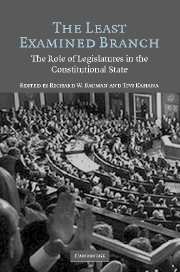Book contents
- Frontmatter
- Contents
- Foreword: Legislatures in the Constitutional State by Amy Gutmann
- Contributors
- New Ways of Looking at Old Institutions
- PART ONE LEGISLATURES AND DEMOCRATIC THEORY
- 1 Principles of Legislation
- 2 An Exact Epitome of the People
- 3 Political Accountability, Proxy Accountability, and the Democratic Legitimacy of Legislatures
- 4 Constitutionalism, Trade Legislation, and “Democracy”
- PART TWO LEGISLATING AND DELIBERATING IN THE DEMOCRATIC LEGISLATURE
- PART THREE CONSTITUTION MAKING BY LEGISLATURES: THE EXPLICIT VERSION
- PART FOUR CONSTITUTION MAKING BY LEGISLATURES: THE IMPLICIT VERSION
- PART FIVE CONSTITUTIONAL INTERPRETATION AND APPLICATION BY THE LEGISLATURE
- PART SIX IS LEGISLATIVE CONSTITUTIONALISM POSSIBLE?
- PART SEVEN THE LEGISLATURE IN DIALOGUE: DOMESTIC AND INTERNATIONAL CONTEXTS
- Index
4 - Constitutionalism, Trade Legislation, and “Democracy”
Published online by Cambridge University Press: 06 August 2009
- Frontmatter
- Contents
- Foreword: Legislatures in the Constitutional State by Amy Gutmann
- Contributors
- New Ways of Looking at Old Institutions
- PART ONE LEGISLATURES AND DEMOCRATIC THEORY
- 1 Principles of Legislation
- 2 An Exact Epitome of the People
- 3 Political Accountability, Proxy Accountability, and the Democratic Legitimacy of Legislatures
- 4 Constitutionalism, Trade Legislation, and “Democracy”
- PART TWO LEGISLATING AND DELIBERATING IN THE DEMOCRATIC LEGISLATURE
- PART THREE CONSTITUTION MAKING BY LEGISLATURES: THE EXPLICIT VERSION
- PART FOUR CONSTITUTION MAKING BY LEGISLATURES: THE IMPLICIT VERSION
- PART FIVE CONSTITUTIONAL INTERPRETATION AND APPLICATION BY THE LEGISLATURE
- PART SIX IS LEGISLATIVE CONSTITUTIONALISM POSSIBLE?
- PART SEVEN THE LEGISLATURE IN DIALOGUE: DOMESTIC AND INTERNATIONAL CONTEXTS
- Index
Summary
Under the legislative procedure – the so-called fast track – that the Trade Act of 1974 established to expedite the process of negotiating and implementing international trade agreements, trade legislation occurs in two phases. First, Congress statutorily authorizes the president to negotiate an international trade agreement and articulates what the president's general negotiating objectives should be. Second, Congress considers, within an expedited time frame and without the option of amendment, whether to accept or reject legislation proposed by the president to implement these agreements. The fast-track procedure was used to enact legislation implementing the North American Free Trade Agreement (NAFTA) and the World Trade Organization (WTO). This chapter places trade legislation within a broader discourse on foreign affairs as it relates to democratic and constitutional theory – a connection rarely made in existing literature.
Critics mounting a “democratic deficit” objection against the fast-track procedure have argued that, in the name of free trade, citizens are asked to agree not just to liberalization of trade policies protecting particular industries, but to changes in their broader way of life relating to employment security and health, safety, and environmental regulation. The fast track, the objection goes, exacerbates this corrosive dynamic by imposing constraints on the trade legislation process, through reductions in participation in and the transparency of the process, and through its prohibition against legislative amendment. These constraints have led to regulatory outcomes contradictory of popular concerns the conventional legislative process would have recognized.
- Type
- Chapter
- Information
- The Least Examined BranchThe Role of Legislatures in the Constitutional State, pp. 76 - 92Publisher: Cambridge University PressPrint publication year: 2006
- 1
- Cited by



